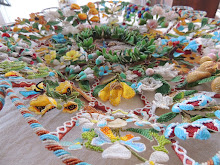I have had a special request to look at this little gown a little bit more, and show a bit of the shadow applique & what it is~
When we got this mid 19th c Christening gown, it was literally in shreds. The back opening had several large vertical tears from both the waist and bottom of the center back opening, down and into the shadow applique at the hem
To help stabilize the tears I use silk crepeline nearly exclusively. It is gossamer fine, and comes in white and black~ laid onto another fabric it simply cannot be seen, but is super strong and woven densely enough to give a great base for stitching and anchoring to
I turned the gown inside out and laid a strip of the crepeline over the entire length about 1/2" wide. I did not want to just put a seam in these tears, as the seam allowance needed makes a distortion in the lay of the garment. I then did a zig sag darn stitch back and forth the entire length~ this same stitch was commonly used in the period~ and as you can see above, once finished the horrible shreads are no longer.
The bodice looked horrible, that is certainly true~ not only was the center panel a shamble, the sides were worn thin and shredding as well. ( I will note here that this is a fine muslin gown, all natural fibers.) Upon closer examination the bodice really wasn't in that bad of condition, all its pieces were there, and it hadn't been 'damaged' per say~ just the stitching had come undone. Now if it has been chewed by a mouse, that would have been a different story, but since it hadn't, it was mainly just another puzzle that had to be reassembled
I did the side panels of the bodice first~ several zig zag vertical darns were necessary~ I only closed the most severe ones and left what was not distracting form the overall appearance
This is one of the shadow applique sections, just a smaller version of that seen on the hem. Shadow applique is just what it sounds like, the reverse of the fabric has pieces of other fabric appliqued in place to make a shadow, and in turn a design on the front~ very subtle and beautiful. Like shadow embroidery, it must be done on a sheer fabric, or the effect looses purpose. On this dress, hundreds of squares of the same muslin that the gown was made from, were folded and appliqued to the back to make this lovely sawtooth pattern. I simply whipped them back down with weensie stitches to make them complete again.
Here I have all three sections complete, and am backing the two lace insertions with crepeline. Once I had the lace windows backed in the crepeline, I tacked the lace down to it. Note that this picture is a view of the back of the bodice~in shadow applique the seam allowance is turned under so there are no raw edges!
There were two small sections of lace missing, but again, in my book, less is more, so I left them and felt no need to try and match laces with something unoriginal to fill them in
I was honored to breathe new life into this precious little gem, and hope you will try your hand at shadow applique~ its quite simple, and can make a plain gown into a masterpiece. I have seen colored fabrics used to beautiful effect, so give it a try~ just remember your applique design with be a mirror image of your design on paper!
Friday, October 25, 2013
Subscribe to:
Post Comments (Atom)

































1 comment:
Rachel,
I think what you have done with this dear little gown is amazing! The time and dedication you put into your work shows the passion you have for preserving the past. I am happy to have found your blog and enjoy visiting it, and learning from it, each time I visit.
Happy day! Joan
Post a Comment